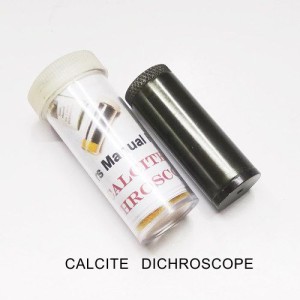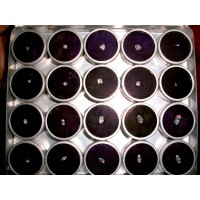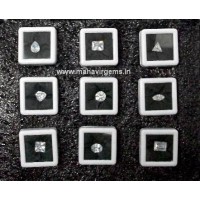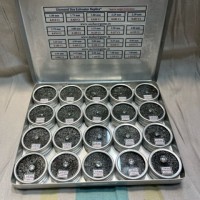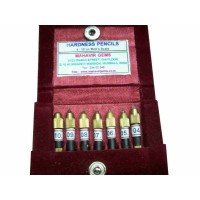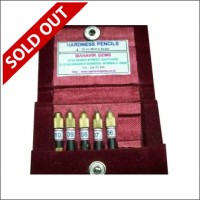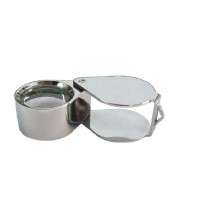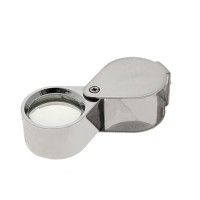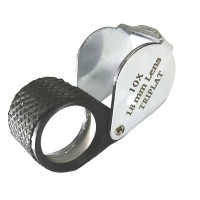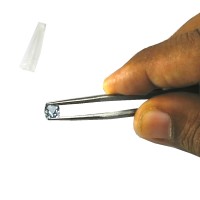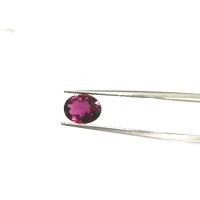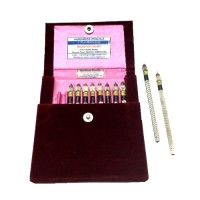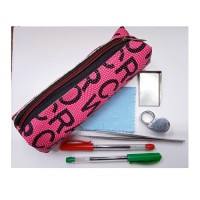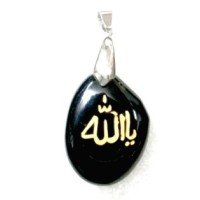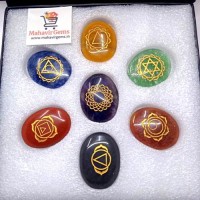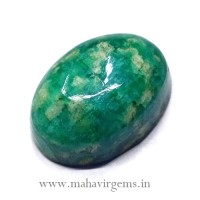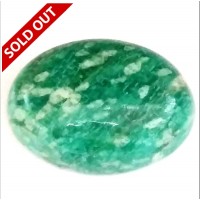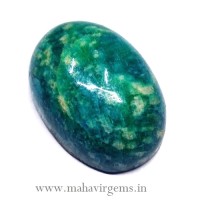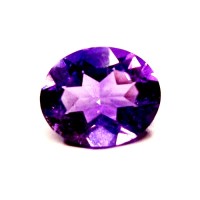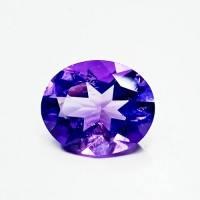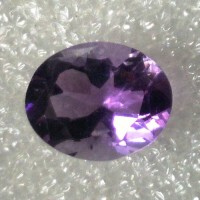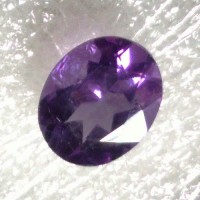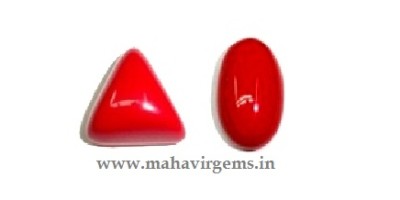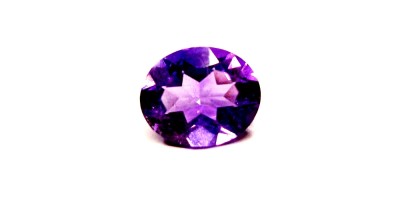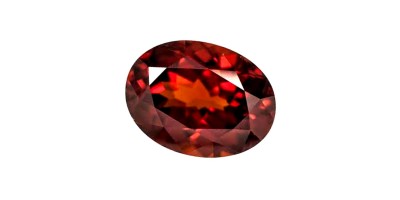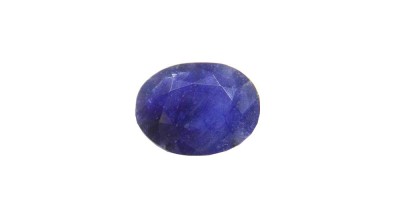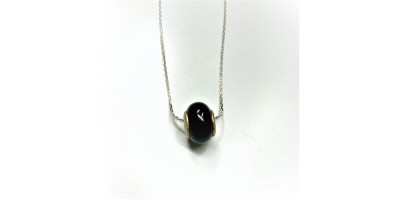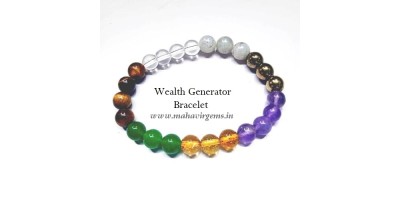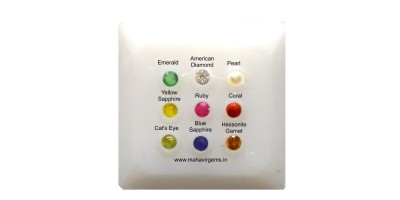- This tool is of a Generic Heavy Duty metal tube measures a compact approx 45 mm in length and 15 mm in diameter.
- Fixed focus for instant differentiation.
- Designed with light weight (18.5 grams ) for ease of use.
Calcite Dichroscope
Calcite dichroscope is a handheld important pocket tool which works on principals of optical properties for viewing the different colors or shades of a pleochroic piece of rough / faceted gemstones. This makes it an essential part of any gemologist's or lapidary's basic gemology toolkit. Shows whether or not a stone is dichroic (reflects two colors). It is also a very important tool for the students learning geology / gemology.
Made with calcite for long lasting use. Protective plastic case included.
Calcite dichroscope provides one of the fastest and easiest method for differentiating transparent stones of the similar color from the another. Using it, one can easily distinguish a Ruby gemstone from its simulant a red Garnet or a red Spinel (one of the popular “simulant" stones seen ), Typically, a garnet will just look red in both windows when viewed through a dichroscope whereas Ruby will show two different shades in two different window. A blue sapphire gemstone from fine blue Spinel or a Tanzanite gemstone, an amethyst from purple glass, or an emerald from many imitations and look-alike commonly sold in the market.
We normally recommend a calcite type (not a polarizing dichroscope). It is a small tubular-shaped pocket friendly most important instrument for the gemstone identification. Approximately 45 mm in length and 15 mm in diameter. When you look through a dichroscope you will see two small round overlapping or closely connected windows at the opposite end. When colored transparent rough / faceted gemstones are viewed through the dichroscope, some will show the same color in both round windows, while few may show two colors or two different tones or shades of the same color.
Here’s how a calcite dichroscope works....
When a single ray of light enters a colored gemstone, depending on the optical properties of that stone, it will either continue traveling through as a single ray or get divided into two rays.
Stones through which it continues as a single ray are identified as “single refracting”; stones
and while other gemstones wherein it splits and travels as two rays are “double refracting.” These stones are identified as “dichroic” (di = two; & chro = color).
Some stones exhibits three colors when viewed with the dichroscope at different directions. These stones are identified as trichroic (tri = 3; chro = color). These stones are also double refracting but when a light enters from certain directions we get one pair of rays (traveling at specific angles and variation in speeds); while when it enters from any another direction, it exhibits a different pair of colors / tones . In the second condition, one of the two rays will travel at a different angle and speed from either of the two rays in the first place. Thus it exhibits the third color.
Trichroic stones like andalusite, Iolite, etc.. will show all the three colors, but only two at a time while you rotate the rough/ gemstone in different direction.It’s advisable to carry a dichroscope with you at gem shows. A piece of garnet or a glass is a lot cheaper than a piece of ruby, and it’s not uncommon for them to get mixed knowingly or accidentally. They are often found in the same geographical areas and mines. (Identifying the stones in rough parcels could be bit difficult). Dichroscope can’t eliminate all possibilities of , but they do help in making instant eliminations when one can’t perform complete through examinations.
Here is a quick list of Common Gem stones And its Dichroism
Andalusite – Yes (trichroic)
Apatite – Yes, weak
Axinite – Yes, Strong
Beryl – Yes, but usually weak
Chrysoberyl – Yes, but usually weak
Danburite – Yes, weak
Diopside – Yes, weak
Garnet – No (occasionally a color change garnet will show an anomaly)
Iolite – Yes
Kyanite – Yes (Strong)
Opal – No
Orthoclase – No
Peridot – Yes, but very weak Quartz – No
Ruby/Sapphire – Yes
Scapolite – Yes
Spinel – No (ADR)
Sphene – Yes
Spodumene – Yes (kunzite, hiddenite…)
Tanzanite – Yes (Strong)
Tourmaline – Yes
Topaz – Yes
Zircon – Yes
for more technical details : CLICK HERE
Make in India
Skill India
#Gemmology #gemology #calcite #dichroscope #gems #testing #buy #online #gemologist #instrument #dichroism #genuine #important #students #laboratories #make-in-India #skill-India
| Kits & Instruments | |
| Dimensions of the Instrument | compact approx 45 mm in length and 15 mm in diameter |
| Weight of the instruments | Gross Weight 23 gms Approx Net Weight 18 gms Approx |
| Other Details | It is a small tubular-shaped pocket friendly most important instrument for the gemstone identification. |
| Manuals | Provided |
| Usability | Very easy to use with basic gemology knowledge |
| Working Principal | Theory of Light |
Calcite Dichroscope
- Product Code: DichroscopeMG001
- Availability: 5
Related Products
Fancy Diamond Cuts Replica
Fancy Gem Cuts Replica Fancy Gemstones Cuts Replica sets for gemologists & Jewelry Designers b..
Fancy Diamond Cuts Replica ( 9Pcs)
Fancy Gem Cuts Replica Fancy Gemstones Cuts Replica sets for gemologists & Jewelry Designers b..
Diamond Size Estimator Replica ( 20 Pcs CZ)
Diamond Size Estimator Replica ( 20 Pcs CZ )Use our Diamond Weight estimator tool box to estim..
Mohs Scale 4-10 Hardness Pencils - Set of 7 Pencils
Discover the perfect tool for gemstone identification with Moh's Scale Gem Hardness pencils. These s..
Mohs Scale 6 -10 Hardness Pencils - Set of 5 Pencils
Discover the perfect tool for gemstone identification with Moh's Scale Gem Hardness pencils. These s..
10x Jeweller's Loupe SS Eco
10x Jeweller's Loupe (SS Eco) – Precision Meets AffordabilityExperience sharp magnification and clar..
10x Jeweller's Loupe SS
10x Jeweller's Loupe (SS) – The Perfect Tool for Precision & ClarityUnlock the finest details of..
10x Black Jeweller's Loupe SS
10x Black Jeweller's Loupe (SS) – Precision for Gemstone Inspection Enhance your gemstone and jewel..
Diamond Tweezer
Diamond Tweezers These diamond tweezers are superbly balanced and well-made, the very best quality ..
Diamond Tweezer Eco
Gemology/ Diamond Tweezers Eco These tweezers are perfectly balanced and well-made, the very best q..
Mohs Scale 1-10 Hardness Pencils - Set of 10 Pencils
Discover the perfect tool for gemstone identification with Moh's Scale Gem Hardness pencils. These s..
Gem Tool Kit
Gem / Diamond Grading Tool Kit A perfect tool kit for the beginner's in the fields of di..
Tags: Dichroscope, calcite, gemology, tool, instrument, identification, dichroscope for sale,
Specials
1 Allah Calligraphy on Black Onyx
Allah Calligraphy on Black Onyx – A Divine MasterpieceDiscover the exquisite Allah Calligraphy on Bl..
10x Black Jeweller's Loupe SS
10x Black Jeweller's Loupe (SS) – Precision for Gemstone Inspection Enhance your gemstone and jewel..
10x Jeweller's Loupe SS
10x Jeweller's Loupe (SS) – The Perfect Tool for Precision & ClarityUnlock the finest details of..
10x Jeweller's Loupe SS Eco
10x Jeweller's Loupe (SS Eco) – Precision Meets AffordabilityExperience sharp magnification and clar..
7 chakra Symbol Engraved Healing Gemstone Set
This set of 7 chakra Symbol Engraved Healing Gemstone Set for Reiki helps with both physic..
Amazonite Oval Faceted 10.85 Carats
Experience the Serenity of Amazonite: A 10.85 Carat GemstoneThis stunning 10.85 Carat (11.92 Ratti) ..
Amazonite Oval Faceted 11.65 Carats
Beautiful mesmerizing 11.65 Carats Oval Cabochon of Natural Unused Amazonite for astrological purpos..
Amazonite Oval Faceted 27.86 Carats
27.86 Carat Natural Green Amazonite GemstoneExperience the serene beauty of this stunning 27.86 Cara..
Amethyst Oval Faceted 2.96 Carats
Beautiful Stunning bright purple Amethyst Oval shaped faceted not commonly available. This gem..
Amethyst Oval Faceted 2.97 Carats
Beautiful Stunning bright purple Amethyst Oval shaped faceted not commonly available. This gem..
Amethyst Oval Faceted 3.04 Carats
Beautiful Stunning bright purple Amethyst Oval shaped faceted not commonly available.This gems..
Amethyst Oval Faceted 3.15 Carats
Beautiful Stunning bright purple Amethyst Oval shaped faceted not commonly available.This gems..




